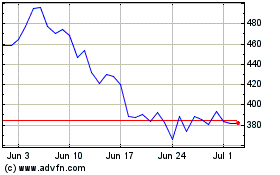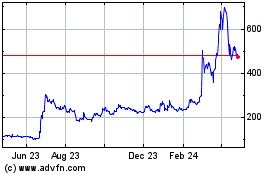The Inside Story Of The Roger Ver Vs. CoinFLEX Conflict
26 July 2022 - 8:18AM
NEWSBTC
The infamous Roger Ver is back in the headlines for all the wrong
reasons. Like many players in the industry, the derivatives
exchange CoinFLEX recently ran into financial trouble.
Surprisingly, they blamed it all on Roger Ver and the circus
started. Luckily for us, Chinese journalist Colin Wu covered “the
entire insider details through a source close to the situation” in
his newsletter. However, as you can see, it’s an anonymous source.
So, take the story we’re about to analyze with a grain of
salt. The summary of the situation according to Wu: “On June
24, 2022, the exchange CoinFLEX announced that it made the decision
to halt user withdraws, and the price of the platform Token FLEX
subsequently plummeted, from $4.30 to less than $1.50 in four
hours. At the same time, FlexUSD, the platform’s stablecoin, also
began to de-peg, with prices dropping as low as $0.23.” The funny
thing is that both entities were clearly in business together. On
May 14th, Roger Ver tweeted, “Interest paying FlexUSD by
CoinFLEX is on its way to being the default stable coin for
the whole SmartBCH ecosystem if USDT & USDC don’t move
quickly.” How did everything deteriorate so fast? That’s what this
article’s about. Interest paying #FlexUSD by @CoinFLEXdotcom
is on its way to being the default stable coin for the whole
@SmartBCH ecosystem if #USDT & #USDC don’t move
quickly.https://t.co/HG14Ik6U0o — Roger Ver (@rogerkver) May 14,
2022 Roger Ver Vs. CoinFLEX, The Play By Play The story starts with
CoinFLEX announcing to their partners that they “opened a special
account for Roger Ver.” The account’s characteristics guaranteed
that Roger Ver “would not be liquidated immediately if it fell
below the maintenance margin, but rather that he would be given
sufficient time to make a margin call.” Nothing special here, the
man is a high-net-worth individual, deals like this are a dime a
dozen in high finance. As a guarantee, Roger Ver offered “a
margin of BCH,” valued “at around $400.” Then, the Terra collapse
happened and the whole crypto market crashed. By the time CoinFLEX
”faced a liquidity crisis,” Bitcoin Cash was worth around $120.
It’s still at that price range at the time of writing. This is
where things get insane. The biggest revelation of Wu’s story is at
the end of this paragraph. “If that were all, CoinFLEX would have
been able to cover its shortfall. However, prior to this, CoinFLEX
had issued its own stablecoin, FlexUSD, like other exchanges. At
this point, CoinFLEX used FlexUSD to buy a large amount of FLEX
from the secondary market and opened short position to hedge the
spot price. However, the counterparty to this short position was
also Roger Ver!” As we’ve seen happen again and again, “when the
withdrawal restriction announcement was made, CoinFLEX’s total
funds began to fall in a cyclical fashion.” And all hell broke
loose. BCH price chart on Coinbase | Source: BCH/USD on
TradingView.com An All-Out Twitter War On June 27th, the company’s
CEO Mark Lamb tweeted, “CoinFLEX made the decision to halt user
withdrawals on June 23, shortly after a long-time customer of
CoinFLEX went into negative equity. ” Immediately after, the rumor
that Roger Ver was that “long-time customer” began circulating.
Recently some rumors have been spreading that I have defaulted on a
debt to a counter-party. These rumors are false. Not only do I not
have a debt to this counter-party, but this counter- party owes me
a substantial sum of money, and I am currently seeking the return
of my funds. — Roger Ver (@rogerkver) June 28, 2022 The Bitcoin
Cash leader went on the offensive and tweeted a statement obviously
written by a lawyer. “Recently some rumors have been spreading that
I have defaulted on a debt to a counter-party. These rumors are
false. Not only do I not have a debt to this counter-party, but
this counter-party owes me a substantial sum of money, and I am
currently seeking the return of my funds.” How could those two
statements be true? Remember that “the counterparty to this short
position was also Roger Ver!” He had a long track record of
previously topping up margin and meeting margin requirements in
accordance with this agreement. We have been speaking to him on
calls frequently about this situation with the aim of resolving it.
We still would like to resolve it. — Mark Lamb 💪 (@MarkDavidLamb)
June 28, 2022 However, Mark Lamb was not having it. Even though
both parties were negotiating, Lamb took to Twitter and stated,
“CoinFLEX also categorically denies that we have any debts owing to
him.” Plus, “Roger Ver owes CoinFLEX $47 Million USDC. We have a
written contract with him obligating him to personally guarantee
any negative equity on his CoinFLEX account and top up margin
regularly.” Even if CoinFLEX is right in this instance, did they
have to air their dirty laundry in public? Roger Ver Vs. CoinFLEX,
The Aftermath Back to Colin Wu’s newsletter: “In the end, Roger
Ver’s position was completely worn out and turned into negative
equity, while CoinFLEX was left with a lot of delisting FLEX. It
was revealed that CoinFLEX had a real loss of $120 million,
including losses from the de-peg of the stablecoin FlexUSD and the
loss of withdrawals (less than $10 million) due to the collapse of
the SmartBCH cross-chain bridge, which was built by CoinFLEX.” And
the fact of the matter is that, even if Roger Ver’s debt caused
this, CoinFLEX’s risk management team has a few questions to
answer. “Roger Ver became almost the only counterparty to the
exchange, and this only counterparty had the privilege of not
replenishing the margin in time,” Wu concludes. It was an
unfortunate sequence of events, but both parties signed those deals
and both parties took to Twitter to resolve what should’ve been a
private matter. Shame all around. Featured Image by Gerd
Altmann from Pixabay | Charts by TradingView
Bitcoin Cash (COIN:BCHUSD)
Historical Stock Chart
From Mar 2024 to Apr 2024

Bitcoin Cash (COIN:BCHUSD)
Historical Stock Chart
From Apr 2023 to Apr 2024
